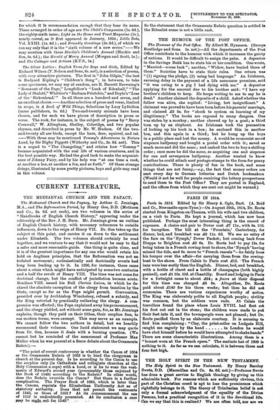CURRENT LITERATURE.
THE MEDIAEVAL CHURCH AND THE PAPACY.
The Mediaeval Church and the Papacy, by Arthur C. Jennings, M.A., and The Reformation Period, by Henry Gee, D.D. (Methuen and Co., 2s. 6d. net each), are two volumes in the series of "handbooks of English Church History," appearing under the editorship of the Rev. J. H. Burn. Mr. Jennings gives an outline of English Church history, with necessary references to outside influences, down to the reign of Henry VII. Dr. Gee takes up the subject at this point, and carries it on down to the settlement under Elizabeth. The two volumes should certainly be read together, and we venture to say that it would not be easy to find a safer and more reasonable guide. One thing is quite clear, and it is of the greatest importance for any one who would retain his hold on Anglican principles, that the Reformation was not an isolated movement; ecclesiastically and doctrinally events had long been leading up to it. In 1296, for instance, there came about a crisis which might have anticipated by some two centuries and a half the revolt of Henry VIII. The time was not come for doctrinal change, but the conflict of jurisdiction became acute. Boniface VIII. issued his Bull Clericis Laicos, in which he do.. dared the absolute exemption of the clergy from taxation by the State, except so far as the Pope might permit. Convocation, presided over by Archbishop Winchelsey, refused a subsidy, and the King retorted by practically outlawing the clergy. A com- promise was effected ; the Pope explained away his pronouncement, and the clergy yielded, not without some gain, for, as Mr. Jennings explains, though they paid on their tithes, their surplice fees, to use modern terms, were exempt. This may serve as an example. We cannot follow the two authors in detail, but we heartily recommend their volumes. One lucid statement we may quote from Dr. Gee, because it deals with a burning question. (We cannot but be reminded of the amazement of Professor Max Mailer when he was present at a fierce debate about the Ornaments Rubric) :-.
"The point of recent controversy is whether the Canon of 1604 or the Ornaments Rubric of 1662 is to bind the clergyman in church at the present day. Is he according to the Canon to use the surplice only (in Cathedrals and collegiate churches at the Holy Communion a cope) with a hood, or is he to wear the vest- ments of Edward's second year (presumably those enjoined by the Book of 1549) according to the Rubric ? In other words, does the Rubrics override the Canon? But there is a further complication. The Prayer Book of 1662, which is later than the Canons, reprints the Elizabethan Uniformity Act as of statutory authority. Does that act permit the vestments of 1549, or those of 1552 ? At its commencement the use of 1552 is undoubtedly presented. At its conclusion a case MAY be matt OA for 1549." -
So the statement that the Ornaments Rubric question is settled in the Ritualist sense is not a little rash.
























































 Previous page
Previous page